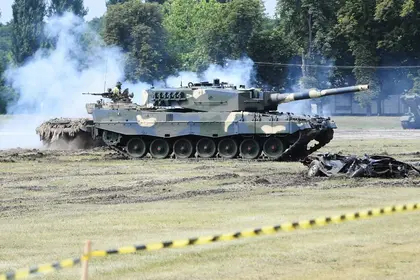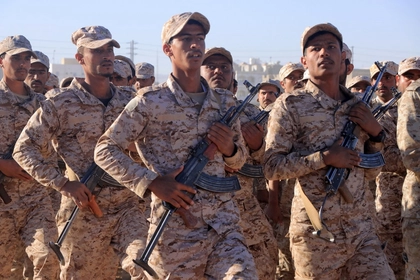Germany has finally caved to pressure and announced it will allow delivery of powerful German-made Leopard tanks to help Ukraine repel Russia's reinvasion.
The announcement is undoubtedly massive and comes after months of requests from Kyiv for heavy fighting vehicles, yet the Leopard tank saga is far from over…
Tell me about this Leopard 2 tank Ukraine is getting. Is it any good, and for what? How might these tanks help the Ukrainian army?
The Leopard 2 tank is a classic German design and a direct descendent of the famous German Tiger and Panther tanks of World War II. The vehicle is heavily armored, particularly from the front and equipped with top-of-the-line optics and sensors, and a powerful cannon firing ammunition that can destroy any Russian tank at practically any engagement range.
A Leopard 2 tank in the hands of the Armed Forces of Ukraine (AFU) would be most dangerous to Kremlin forces by taking a ridgeline position at long range, in open terrain, where it could pick off Russian vehicles at ranges well beyond which the Russian tank or armored personnel carrier could shoot back accurately, and in most cases before the Russian crew understood it was being targeted.
The closer and more restricted the terrain – towns and villages, forests, and swamps – the less a Leopard 2 crew would be able to exploit these advantages.
Germany has been making Leopard 2 tanks since 1979 and updating the tank constantly. Which type of Leopard tank are the Ukrainians going to receive?

ISW Russian Offensive Campaign Assessment, November, 24, 2024
That is still being discussed. The model Ukraine is reportedly most likely to get is called a Leopard 2 A4, which is head and shoulders better than practically all tanks operated by the Russian army, and by most measures on par with the few late model T-90 tanks the Russians have in Ukraine.
However, news reports of possible delivery to Ukraine of later-model A5, A6 and A7 models are appearing. The latest model Leopards would be more effective in tank-to-tank slugging matches, and in resisting the latest anti-tank missiles. They would be heavier, and carrying improved protection against improvised explosive devices, which is not a big threat to tanks in Ukraine.
OK, what are the weak points of the Leopard 2?
A major problem is that with a weight of 55-65 tons (depending on the model) the Leopard 2 is heavier than the capacity of most bridges in Ukraine, meaning the tanks will have trouble shifting from sector to sector and their attack directions will be predictable.
Like in all modern tanks, the Leopard 2’s side, roof and rear armor is relatively thin and vulnerable to attack by most anti-tank weapons in the Russian inventory.
Another problem common to all tanks in the Russo-Ukraine war context is that when one breaks near the front it is often spotted by drones and pounded into scrap by artillery, before the crew can fix it. Russia-made and Ukraine-made tanks have the same weakness and they break down more often, and among Western main battle tanks the Leopard 2 has a reputation for reliability. But if one is to lose a busted tank to artillery a Leopard 2 is an expensive loss.
Perhaps the biggest weakness of the Leopard 2 is that Ukrainian commanders will be tempted to deploy the tanks in close terrain without infantry. The Turkish army made that mistake in Syria and lost eight Leopard 2A4 tanks in a single battle back in 2016.
Where are they coming from? Just Germany?
No, not just Germany. One of Berlin’s pre-conditions for permitting shipment of Leopard tanks to Ukraine was that not only Germany send them. Officials from Poland, Sweden, Spain, Greece, Finland, Canada, Sweden and the Netherlands have in recent weeks suggested they might send Leopards to Ukraine along with Germany.
How many of these spiffy German tanks, from all sources, is Ukraine actually going to get?
Talks are still in progress among NATO states about that, and as of Jan. 25 it appeared that no final collective decision on tank counts and delivery timing had been reached. The trend of news reporting was that once details are ironed out about 80 Leopard 2 tanks could wind up in Ukrainian hands initially.
Is that all? How many of these Leopard tanks could Ukraine get, theoretically?
That’s a separate issue, which frankly no-one in NATO really wants to shout out in public, because every Leopard sent to Ukraine is either a main battle tank removed from a NATO army stocks, or a tank bought directly.
Rheinmettal said on Tuesday that it has 29 Leopards on hand that it could send to Ukraine by late April or early May, another 22 it could refurbish out of storage and deliver by the end of 2023, and another 88 that it could “make available”. It’s not clear, right now, who would pay Rheinmettal. Die Welt reported on Wednesday that there are 2,200 Leopard tanks of various marks in European militaries alone.
When will Ukrainian crews in the field get their hands on them?
That depends on how fast the crews can be trained, and NATO capacity to train tank crews – never mind Ukrainian ones needing translators – is not unlimited. At the same time that Ukrainian crews are to be trained, NATO states operating Leopard 2 tanks must also train their own crews, or accept loss of readiness.
Speculation in military media seems to agree it will take at least two months to train a single Ukrainian crew, and if the task is training dozens or hundreds of crews, the process will be slower. Most likely, the Ukrainian army will be unable to operate any Leopard 2 tanks at all before late Spring, with numbers of tanks in the field rising gradually after that.
Once the Leopards go into battle, what will happen? Will it end the war quickly?
The answer to that question depends on whether Ukraine army commander Valeriy Zaluzhny decides to commit Leopard 2 tanks to battle in small groups or as part of a major formation, and equally critical is how long he wants to wait before making that decision.
If he chooses the small-scale approach, then in most small sectors wherever Leopard 2s are present, the Ukrainian army should be able to stop cold any Russian mechanized assault, or blast any Russian armored vehicles trying to defend a village or a position.
Even a couple of 4-tank platoons of Leopard 2s deployed and operated intelligently in the vicinity of the city of Bakhmut would, for instance, probably shut down any chance of a Russian army armored breakthrough, no matter what happened with the infantry fighting in the city.
If General Zaluzhny were to decide to "go large", and critically, give his infantry and artillery time to train at operating alongside dozens of Leopards, then a ground attack tipped with Leopard 2 tanks would have a real chance of inflicting a major operational defeat on Russian forces
For instance, by pushing 100 km. or more to the gates of Mariupol or the Crimean border. But attempting a large-scale offensive like that without serious combined arms training would be a military risk much higher than the Ukrainian high command has seemed willing to take, ever.
The AFU would need Leopard 2 tanks on the ground and a minimum of about a month of practice, before kicking off a major offensive like that.
You can also highlight the text and press Ctrl + Enter






